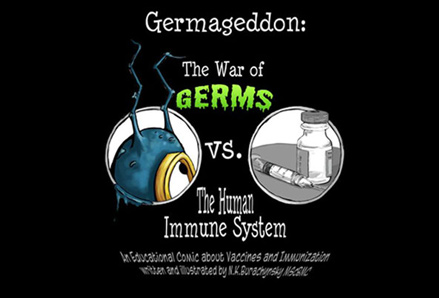Do you understand how your immune system works to protect you from disease? Do you know how vaccines work?
These questions are answered in the graphic novel Germageddon: The War of Vaccines Vs. The Human Immune System. Created, written, and illustrated by Natalia Burachynsky, a Medical Illustrator and Visualization specialist, the comic book explains immunity and the power of vaccines. We recently asked Natalia, an avid traveller who has visited New Zealand, Thailand, Laos, Indonesia, Malaysia, Greece, Portugal and many other European countries to tell us why she developed Germageddon for her Master’s of Science in Biomedical Communications at the University of Toronto.
What is Germageddon?
Germageddon is an educational graphic novel that is unbiased, engaging, and humorous. It was created to inform and educate people on the science and benefits of immunization and to explain how the human immune system works. Germageddon takes place on a busy train. Gordo the Germ, runs into an old acquaintance. Gordo is moving on, times are tough, the humans he infects are becoming immune to him. He strikes up a conversation with his friend who is unaware of the dangers that strong immune systems present to the Germ world, and proceeds to explain what ‘vaccines’ are and how they work. With the help of other germ examples, fellow pathogens, and metaphors, the Germ characters help unravel the mystery and clear up the confusion about immunization and vaccines.
Why did you create Germageddon?
There is general consensus within the mainstream medical community that vaccines improve immunity to disease, save lives, and that their benefits far outweigh the risks. Despite this, many people continue to believe anti-vaccination advocates who question vaccine safety and efficacy. In Canada and the US, for example, adults are not getting their routine vaccinations updated, putting themselves and others around them at risk.
To help people make informed decisions about their health and vaccination, I believe that they must have access to reliable information. There is an urgent need to teach people on the importance of vaccination to counter the misconceptions propagated by very persuasive anti-vaccine lobbyists.
A lack of knowledge in general science and a low science literacy rates are two obstacles contributing to this anti-vaccination trend. If you’re not familiar with human biological functions, it can be difficult to make good health choices. Using visually rich, engaging, and entertaining educational tools that address the safety, science and importance of vaccinations, Germageddon helps readers understand complex scientific concepts related to immunity and vaccines.
Why a graphic novel?
Germageddon is ‘Graphic Medicine’, a new area of educational visualization. This science-themed comic addresses complex ideas using visual metaphors and entertaining storylines making an important public health topic highly accessible to individuals with various levels of literacy and reaching across diverse cultural and socio-economic backgrounds.
Germageddon achieves this without the use of scientifically challenging language, using well-conceived visuals and thought-provoking Socratic dialogue. This form of dialogue is a useful and popular format for expressing arguments and discussions as well as illustrating scenarios and character details of the individuals involved in the discussion. Socratic dialogue works wonderfully as an educational tool because it effectively addresses concerns and questions that an individual may have about a subject. Socratic dialogue is also useful in clearing up a misconceptions and misinformation while removing the necessity for a reader to ask or seek the answer themselves, often resulting in a ‘safe’ learning environment.
There is a lack of accurate visuals, illustrations and animations targeted at educating people on the science and safety of vaccination. Germageddon gives individuals a sound knowledge of microbiology concepts. My graphic novel can also be used to foster science literacy, helping individuals understand scientific terminology, concepts, and evidence so that they can communicate scientific ideas and draw their own conclusions. Current studies embrace the concept of using comics as an innovative and entertaining way of communicating science.
My hope for Germageddon is that it will foster scientific curiosity and literacy, and that it will convince readers to keep up-to-date with their vaccinations. Higher immunization rates can also lower the burden of economic costs associated with hospitalization, decreased productivity, and work absenteeism during a person’s lifetime.
To see Natalia’s work and to download your copy of Germageddon: The War of Vaccines Vs. The Human Immune System go to: www.burachynsky.com.
Image courtesy of Natalia Burachynsky.



